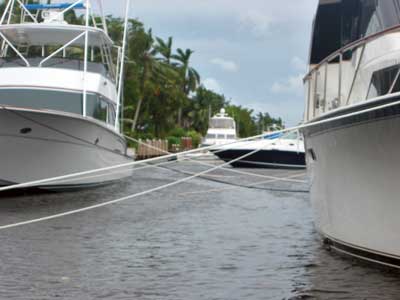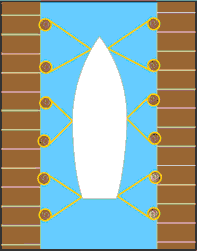Storm Spurs Canal Cooperation
By Elaine Dickinson

Well secured boats line a canal in Florida using a system that spared them
from hurricane damage.
"Safety in numbers" is a concept that's served humans ever since cave men and women first banded together to fend off saber-toothed tigers or warring tribes. So how does it help when a Category 4 hurricane is bearing down on your waterfront home, dock and boat?
The 11 homeowners with boats that live on Brech Kauffman's canal in Lighthouse Point, FL, have a plan: they work together as a neighborhood when storm warnings go up and, through good teamwork, they secure their boats in their canal, using seawalls and private docks to run lines. The system works so well Kauffman, a BoatUS member, said they've weathered no fewer than four hurricanes, including the surprisingly intense Hurricane Wilma in 2005, with nary a scratch on any of their vessels.
"Wilma gave us quite a test," Kauffman said, while aboard his 50-foot Hatteras heading north for the summer. "I feel pretty good with our plan; none of our lines have broken [in hurricanes going back to 1998] so we've been pretty fortunate."
As recently highlighted at a BoatUS-sponsored conference on hurricane preparation, it's generally agreed that getting a boat out of the water and secured on land is the first choice in preparing for a big blow. But not every boat owner can manage this — before a hurricane, marina lifts are working overtime and there are waiting lists for haul-outs; land storage in many places is just not available.
Tips For Tying Lines

An optimum canal tie-up (not to scale)
uses a minimum of eight lines to pilings
or seawalls.
While every waterway is different, BoatUS Marine Insurance has found that there are ways to improve your chances of avoiding damage to your boat from a major storm. For the full guide to preparing your boat for a hurricane, download a free copy of "Hurricane Warning." It includes a checklist of supplies, blank plan forms, diagrams and a hurricane tracking map.
For small waterway tie-ups:
- Vary the types of lines used. Use braidon- braid rather than three-strand nylon as it will stretch 50% less. Also three-strand polyester has less stretch than nylon but is more chafe-resistant.
- Make the polyester lines longer to hold after the nylon braid has stretched in the first wind blasts. (A BoatUS member in Port Charlotte, FL, watched a neighbor's boat that had been centered in a canal get bashed against a seawall because its nylon lines were being stretched too far in gusts.)
- Eight lines should be the minimum.
- Don't run lines to palm trees or other exotics. Pilings, most deep-rooted indigenous trees, and even augers screwed into the ground are a better alternative.
- Don't overload cleats — two lines per cleat is a reasonable limit.
- Run lines to separate pilings and attach as low as possible for strength.
- Remove anchors from bow anchor rollers as the flukes can catch lines and cut them.
For homeowners lucky enough to live on or near a canal or narrow waterway, it could turn out that staying put is the safest choice for boat storage. As BoatUS Marine Insurance has documented by handling claims from dozens of hurricanes over the years, boats on land usually fare better and suffer less damage, but if a boat has to stay in the water, a well-planned "spider web" of lines across canals has spared many boats from damage or total loss. But success takes coordination among neighbors, dock owners and boat owners.
"Using canals has been very effective in some areas," said Dave Wiggins, a Catumet, MA-based marine surveyor who is a veteran of many BoatUS Marine Insurance Catastrophe Teams. The team members are usually the first on scene to find and inspect boats after a hurricane or arrange for salvage. "Using canals can also be unsuccessful if the weather-most boat's lines fail or chafe and it sets up the domino effect. A lot depends on that first boat and how well the lines are secured across seawalls," Wiggins added.
Up A Creek
The chief benefit of using a canal, head of a creek, mangrove or bayou as a hurricane hole is the avoidance of large breaking waves that have done so much to destroy marinas during the past few years of heightened hurricane activity. Smaller waterways will still get storm surge but are less likely to feel the full force that ocean- or bay-front docks will suffer.
"In the bayous of Mississippi, it worked very well," said Wiggins of Gulf Coast boat owners caught up in 2004's Hurricane Katrina. He saw one site in which about 200 boats were secured in a remote bayou and only about 2% of them had damage from being sunk or driven into the woods.
Another benefit of a coordinated canal tie-up is that running longer lines to the shore allows boats in a canal to rise and fall with the storm surge, which is harder to do at a dock. Boats that are anchored or moored can also rise and fall with the surge but face the considerable risk that the anchors will drag or the pennants will fail. Given the large number of boats in some waterways, scope can also be a problem. However, for boats tied up on wider canals, two or three anchors can also be used at the bow and stern.
Another benefit of a coordinated canal tie-up is that running longer lines to the shore allows boats in a canal to rise and fall with the storm surge, which is harder to do at a dock. Boats that are anchored or moored can also rise and fall with the surge but face the considerable risk that the anchors will drag or the pennants will fail. Given the large number of boats in some waterways, scope can also be a problem. However, for boats tied up on wider canals, two or three anchors can also be used at the bow and stern.
While many canal residents have lifts on their docks, insurance claims have also shown that boat lifts are not a good choice during a hurricane. Rainwater often fills the boat to where the weight collapses the lift; in addition, lifts are vulnerable to high winds and storm surge as well.
Being Neighborly
One Neighborhood's Drill
- Let homeowners with small boats know what time of day the canal will be "spider-webbed" so they can get out.
- For remaining boats, charge batteries, strip canvas and tape over hatches and openings; remove valuables and electronics.
- Two teams in tenders work from each end of the canal to drag lines back and forth across the canal. Each boat uses its own lines.
- Lines, or even chain, are placed around the bottom of pilings, which is stronger and not subject to high wind; or lines are run to cleats in sea walls. No one depends on anchors.
- Afterwards, the tenders handle the retrieval of lines and everyone works together to release the lines and get each boat back to its dock.
In many communities, canal residents have pioneered the "neighborhood watch" concept with a coordinated tie up. Part of the success of this depends on all homeowners allowing the use of their seawalls, dock pilings and other fixtures on land. (Memo to self: don’t use palm trees for tying lines — they have such shallow root systems hurricanes can knock them right over.)
Using the group concept, neighbors can purchase spools of larger line and keep them stored and ready. A neighborhood plan is also instrumental in the event that someone is away when hurricane warnings are posted, and arrangements can be made for neighbors to prepare the absentee's boat.
Kauffman said the homeowners on his canal do not have a written plan but are in constant communication before a hurricane and everyone knows what’s going to happen and when. Neighbors with small boats are told how long they have to leave the canal before the lines start going across. (See box.)
With over 300 miles of waterways in Ft. Lauderdale, the city’s Venice-like canals resemble a giant spider web before a storm, said Frank Herhold, executive director of the Marine Industry Association of South Florida. "The canals provide a safe refuge for vessels of all sizes and types. It also works well with our Broward County flotilla plan which moves large groups of vessels, under police escort, upriver before bridges are locked down."
In fact, it is Herhold who makes the call to activate the flotilla plan; normally, boaters have a window of about 3-1/2 hours after an evacuation order has been posted or winds reach 40 mph, whichever comes first, before drawbridges will be shut down for vehicle evacuation.
"The key is the ability to tie a line to other people’s property. You can’t do that without advance permission," said Herhold. "You also have to be a good neighbor and let them do the same with your property."
The only caveats — and there are always a bunch when you are dealing with anything as unpredictable as hurricanes — are the skippers who arrive late to a canal or anchorage, drop a hook and leave in a dinghy, endangering everyone else’s hard work.
Joanne Becker, of Becker’s Marine Services in Ft. Lauderdale and former president of the Waterfront Homeowners Association, who lives at the head of the New River, has seen it time and again.
"We will go up and down the river to help other people tie up," she said. "But some boats come in, drop an anchor and leave, blocking everyone. Many people do not know how to tie up their boats." Becker recommends that any boater showing up in a canal talk to the homeowners there first and ask for assistance. "Most people are very neighborly and most will assist you, if you ask," she said.

